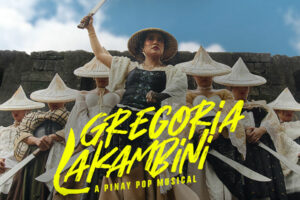By Brontë H. Lacsamana, Reporter
Theater Review
Gregoria Lakambini: A Pinay Pop Musical
Presented by Tanghalang Pilipino
THIS YEAR marks the 150th year of Gregoria de Jesus’ birth, and there have been multiple takes in different art forms telling her story as the Mother of the Philippine Revolution. One of these is Tanghalang Pilipino’s newest production, Gregoria Lakambini: A Pinay Pop Musical, the most youth-oriented retelling of Oryang’s life so far, with its use of pop music and contemporary language.
The musical takes us through the key points of her evolution: having to drop out of school to let her brothers continue their education, meeting Andres Bonifacio, becoming the “power couple” of the revolution as the Supremo and the Lakambini, the death of Bonifacio, and her remarriage and subsequent home life with composer Julio Nakpil.
With a book by Nicanor Tiongson and Eljay Castro Deldoc, it’s unsurprising that the musical is able to capture the fiery energy and vital ideas that make Gregoria de Jesus a fascinating figure. You can tell there was extensive research done across all the milestones of the woman’s life, only shifted in tone so that Gen Z girls can understand it.
Because it has such a clear target audience, anyone who falls beyond it must meet the material where it’s at to fully appreciate what it’s trying to do. This is one of those instances where watching with a teenage daughter or niece could come in handy — does the play succeed at speaking to Filipino girls who have a lot to learn from the Lakambini’s courage, wit, and resilience? Far be it for us older folks to judge.
The music alone makes me inclined to say yes! The songs, composed by Nica Del Rosario and Matthew Chang and arranged by Flip Music Productions, are lively, melodic, and representative of the pop sensibilities we hear from hits today. Ranging from girl group anthems and emotional ballads to energetic rap and dance tunes, the various tracks allow lead actress Marynor Madamesila and her fellow cast members to shine. Delphine Buencamino’s direction and choreography allow the material and its cast to bring the vibrant story to life.
Marco Viaña’s costumes deserve their own shoutout. Blending Filipiniana silhouettes, steampunk leather and fishnets, and streetwear accents to let the six ladies transform into a spunky, makeshift girl group of their own was a great choice. The visuals go well with Mark Lorenz’s set design, which is both functional and reflective of Filipino aesthetics.
As for Ms. Madamesila, who has been doing splendidly in many productions lately (Walang Aray, Side Show), she comes into her own as Gregoria de Jesus in this musical. Her vocals are strong and steady, her emotions clear and complex, and her stage presence always the most compelling. The ensemble of Anya Evangelista, Heart Puyong, Sofia Sacaguing, Sarah Monay, Ynna Rafa, and Murline Uddin hold their own as well, but doubling as comedic modern-day storytellers and dramatic figures in Oryang’s life wears down their effectivity somewhat.
Particularly, Ms. Evangelista’s turn as Andres Bonifacio is promising, the nuances as she assumes the Supremo’s voice and stance evident but not showcased enough. Well-written and injected with contemporary flair as it may be, the book doesn’t really do much with the intriguing queerness of having an all-woman cast play different levels of masculinity and femininity. Perhaps some of that is there, but the cast doesn’t get to play around with it much.
Despite all these elements that, on paper, make this a unique experience, quite a bit of it is reminiscent of Hamilton, in the bursts of historical facts crammed into lyrics and the tracks that spell out Oryang’s name and list down her pieces of advice. Even the choice of an all-female cast feels like a similar gimmick as having people of color play the founding fathers — a reinterpretation that looks revolutionary but doesn’t fully contend with the nuances of a reframed history.
Another form of art that revived Oryang’s forgotten legacy for her 150th year is the film Lakambini, Gregoria de Jesus, which came out just over a week prior to the musical’s opening night. There, the “docufiction” views her spirit as a disembodied voice that has finally been given shape amid malevolent forces, from the corrupt Cavite faction that snuffed out Bonifacio in 1897, to the industry knuckleheads who said no to the 2015 iteration of the film because of a lack of combat.
This musical, while intended for younger audiences, does have similar sensibilities. Sure, the ensemble speaking to Gen Z girls with relatable voices have distracting, shrill reactions to harrowing parts of the Lakambini’s story. They are even shown to squabble amongst themselves as they try to process the more unbelievable parts of her life. But most of all, they grow to appreciate the domestic and revolutionary aspects of their beloved heroine as one and the same, perhaps two sides of a coin.
With an approach that may come across as juvenile to many, Tanghalang Pilipino proves that bold strokes might just be what we need to effectively remember forms of heroism that have fallen under the radar. Gregoria Lakambini: A Pinay Pop Musical is one way of reviving a forgotten legacy, and it might just be the one that reaches the young women and girls who need to hear it the most.
Gregoria Lakambini: A Pinay Pop Musical runs until Dec. 14 at theTanghalang Ignacio Gimenez, Cultural Center of the Philippines Complex, Pasay City. It is recommended for audiences 12 years old and above. Tickets, with prices ranging from P1,954.80 to P2,172, are available via TicketWorld. For more details, visit Tanghalang Pilipino’s social media pages.






